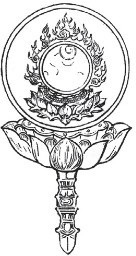Chapter 16 4. The Snake in Sheep's Clothing
Word soon came up that the man's role in procreation was recognized and an altar was erected to it.
The altar has been found in the Hongshan cultural site, but the female one is round and the male one is square.This is in line with our subjective feelings: men are sharp and angular, while women are round and round.No wonder what Nuwa is holding is rules, what Fuxi is holding is moments, women are men and women are men!
But what about a round sky and a round place?
Heaven, isn't it male; Earth, isn't it female?
Sorry, that was later.In ancient times, in the era of Nuwa, women are the sky, and men are the earth.It's just that since a man has a square altar, at least he has a place, and he can compete with a round woman.
So Fuxi transformed himself into a snake god.
How could Fuxi be a snake? , Xi is related to sheep, sacrifice is related to cattle, how can there be snakes?There are weapons.Fuxi is also called Fuxi.Opera, as well as the "I" in Xi characters, are all weapons.Could it be that the snake was actually just the reflection of the weapons in the vessels on the altar?
of course not.
Fuxi's transformation into a snake was not a "cup and bow snake shadow", but a "cultural revolution".In other words, men who are getting better and better are required to reflect their importance in terms of diet and both men and women.
This must lead the snake out of the hole.
Why does it have to be a snake?Because only the snake is the most powerful symbol of men.Bird, just be gentle.Therefore, from the clan to the tribe, and then to the country, the role of the snake will be consistent.In the age of the clan, it is a symbol of reproductive worship; in the age of the tribe, it will become a totem; in the age of the country, it will also become the ancestor.However, most cunning snakes will be in a latent state, and will only reveal their true face when it is time to come out of the hole.
Wonderful Fuxi!He is really a snake, but in sheep's clothing.
The lurking snake god is now a satyr.He is Xi, righteousness, and beauty.Mei, above is the sheep, below is the big.This big one is actually a human being, my lord.If a person is a big person, write "big" standing frontally, such as beautiful beauty; if it is an ordinary person, write "亻" standing sideways, such as pretending to pretend.It can be seen that from pretending to xi, to righteousness, to beauty, this young man Fuxi climbs up the stairs, and every step is inseparable from the sheep.
Good goats too!
Yes, sheep are good and auspicious.Because mutton can be eaten, sheepskin can be used for clothing, sheep dung can be used to fertilize fields, and sheep horns can be used as weapons or musical instruments.Isn't such kind of food and clothing parents immeasurable merit?Isn't such great mercy not auspicious?Isn't Fuxi the goatman with horns on his head beautiful?Shouldn't such a handsome guy from ancient times be the leader?
Of course you should!
In fact, the word auspicious is written as "auspicious sheep" in ancient characters.Sheep is auspicious, that is, the person who crowns the sheep.
So, what is "ji"?Pearl of Red Lotus.The red lotus is the female genitals, the pearl of the red lotus may be the Mani pearl of the Indians, and the Huoqi pearl of the Chinese is the clitoris.Di, is the emperor, written in ancient characters as ▼ or ▽.It may be a whole flower, or a pistil or bud.therefore,
Alas!The jewel of the red lotus is auspicious, and the person of the crown sheep is auspicious.
For the word auspicious, Fuxi occupies most of it.

The artistic image of the six-character mantra, which was originally the upper part of the "Pearl Stupa" at Kongoshan Temple in Nara, Japan, was painted by Wang Yong, quoted from page 155 of Zhao Guohua's "On the Worship of Reproductive Culture".
In this image, at the bottom is a brilliantly blooming lotus flower, which contains a lotus pod with many seeds, and on the top is a flaming orb.Inside the orb, there are lotus flowers, lotus pods, and orbs, which represent the endless life of all things in the world, and the endless creation of life.
There are two thirds of the world, and of course the paternal line will replace the matrilineal line.
But all of this happened quietly.
In the late period of matrilineal society, when the bonfire was lit and night fell, it was still Nuwa or Frog Girl who boarded the altar.We have already seen that appearance and scene in the frogman map of Papua New Guinea: the frog goddess who has mastered the "No. 1 secret" of "life and death" occupies most of the picture, indicating that she is the natural leader.The decorations on her head are fish and birds, which respectively represent female and male reproductive worship, and also indicate that the murlocs and birdmen are her assistants.Surrounding it are flowers representing women and dots representing offspring.
As for the male snake people and sheep people, most of them can only take care of those clay pots, pots, plates, bowls, cups and bowls off stage.Of course they never imagined that the Tao Ding in front of them would turn into bronze in the future and become a symbol of the country and political power.They would never have imagined what price the brothers and sisters would pay in order to win the Central Plains.
Notes:

The artistic image of the six-character mantra, which was originally the upper part of the "Pearl Stupa" at Kongoshan Temple in Nara, Japan, was painted by Wang Yong, quoted from page 155 of Zhao Guohua's "On the Worship of Reproductive Culture".
Notes:
